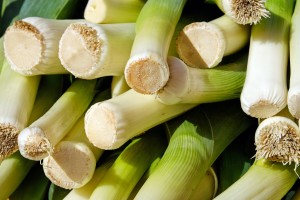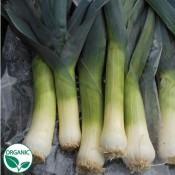
Allium ampeloprasum or porrum
Coveted for their subtle onion flavour, leeks are prized by gourmets and food lovers. They look more like their kin, the lily, than its cousins, onion, and garlic. Leeks have a long cylindrical stem made up of concentric layers of overlapping leaves. Leeks can be used in a variety of ways – boiled, braised, stir-fried, or snipped in salads. The key is not to overcook them because they turn mushy.
Leeks are easy to grow, store well when they are left in the garden, and can be harvested over a long period – from fall to late winter. Planting transplants into the bottom of a 6 – 8″ (15 – 20 cm) trench or furrow will produce white shafts. As plants mature, fill in the trench with soil to just below the first leaves. This “blanching” procedure will produce tender, longer white stalks. Another “blanching” method is to hill or mound soil up around the stems as the season progresses.
Baby leeks can be pulled in early summer for salads. For larger-sized leeks, lift or dig when the stems are between 1 and 2″ (3 – 5 cm) in diameter in late summer.
They are extremely tough and can withstand severe frost. To harvest all winter, apply a thick covering of mulch before the ground hardens and freezes, then dig up stalks as needed.
Grow leeks with beets, carrots, celery, onions, and spinach. They help repel carrot rust flies. Avoid planting leeks near beans and peas.
| Nutrition | Leeks are low in calories. They are a good source of Vitamin C, calcium, phosphorus and potassium |
|---|---|
| Harvesting | Dig or pull anytime the leeks are 2 - 5 cm (1 - 2″) in diameter. Trim the leaves and roots. Leek layers tend to hold soil, so cut off the unusable upper green portion, remove tough outer leaves. Rinse the stems thoroughly if thre is sand or dirt in the folds. |
| Storing | It is better to use leeks once harvested or as soon as possible. But refrigerated in a plastic bag, it will keep for several days. |
Varieties Listing
Bandit has an upright habit, dark blue-green leaves and large white stems. Minimal bulbing. Good disease resistance. The flavour is excellent and the sweetness improves with cold weather.
Back to Organic Edibles.

